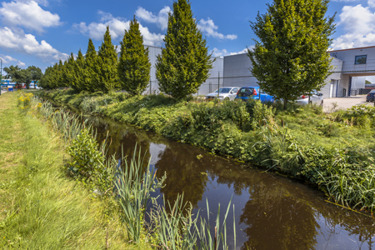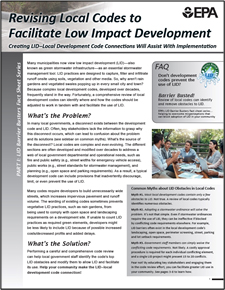Promoting Natural Solutions For Urban Stormwater Management


As a continuation of its efforts to help municipalities reduce the negative impacts of stormwater runoff, the U.S. EPA has announced the publication of the last in its series of 12 ‘Barrier Buster’ fact sheets on low-impact development (LID) for urban stormwater management. Unlike previous fact sheets focused on physical implementations, the latest document focuses on state and local development codes — a key gating factor in permitting the installation of green, stormwater infrastructure and mitigation practices. Here is an overview of how that pivotal factor in the overall program can streamline efforts to resolve a wide range of urban stormwater challenges
Bringing LID To The Forefront
According to the EPA’s introductory fact sheet in the Barrier Buster series, “LID includes a variety of practices that mimic or preserve natural drainage processes to manage stormwater. LID practices typically retain rainwater and encourage it to soak into the ground rather than allowing it to run off into ditches and storm drains where it would otherwise contribute to flooding and pollution problems.”
The final piece in the series, Barrier Buster #12: Revising Local Codes to Facilitate Low Impact Development - Creating LID/Local Development Code Connections Will Assist With Implementation, outlines challenges imposed by state and local development codes (Figure 1). It offers practical examples of how to identify codified resistance to LID best practices and break those barriers down.

Source: EPA 841-F-19-002
Figure 1. This latest in the series of 12 Barrier Buster fact sheets from the U.S. EPA addresses often-overlooked factors for aligning local development codes to facilitate greater use of LID techniques for urban stormwater management.
The overall Barrier Buster series provides a range of practical guidelines for bringing LID strategies to fruition. It also provides examples of successful implementations with environmental and economic benefits ranging from reductions in expensive flood events to improved habitat, better groundwater recharge, and more pleasing aesthetics. For example, earlier pieces in the series have addressed:
- Barrier Buster #3: Costs of Low Impact Development - LID Saves Money and Protects Your Community’s Resources
- Barrier Buster #5: Effectiveness of Low Impact Development - Proven LID Technologies Can Work for Your Community
- Barrier Buster #7: Encouraging Low Impact Development - Incentives Can Encourage Adoption of LID Practices in Your Community
- Barrier Buster #10: Large Volume Storms and Low Impact Development - Using LID Practices in Areas with Intense Rainfall Events
Every Journey Starts Begins A Few Well-Directed Steps
The Barrier Buster #12 fact sheet on overcoming local code restraints outlines three common myths about the obstacles that these codes pose to LID efforts.
- Myth #1: Most local development codes contain only a few obstacles to LID. While that perspective is not necessarily true, it does not need to be a stumbling block. Finding an efficient way to identify potential conflicts is the first step.
- Myth #2: Adopting a stormwater ordinance will solve the problem. Unfortunately, the answer is not quite that simple, but it is not insurmountable either. The key to the solution is understanding the scope of a full range of potentially related development codes.
- Myth #3: Government staff members can simply waive the conflicting code requirements. Changes will not occur overnight, but delivering a clear message outlining LID’s benefits to the right influences can sow the seeds of encouragement as future codes are written, reviewed, or adopted.
Those challenges are real, but are capable of being solved with education and good communication to convince code-related public officials to embrace the benefits and underlying principles of reducing stormwater impacts. The majority of the eight-page document is devoted to educating decision-makers on the potential benefits of LID, describing tools for identifying problematic codes, language for overcoming problematic code restrictions, and incentives and operational capacity for LID adoption.
Don’t Be Discouraged
Here are just some of the valuable guidelines outlined in the document that can make a difference in streamlining the route to better LID practices:
- Awareness. A review of the community’s comprehensive development plan is a good starting point for identifying aspects where LID can be beneficial to that existing plan.
- Communicating With Stakeholders. Because multiple stakeholders — such as community designers and developers, environmental groups, and others — will be involved, it is important to understand overlapping or seemingly conflicting concerns. Discussing how all parties’ interests intersect can go a long way toward earning their buy-in.
- Overcoming Misconceptions. It is not enough to identify oversimplified misconceptions about stormwater plans or best management practices. It is more beneficial to be prepared to spell out how the language of existing plans might get in the way of desirable LID benefits.
- Identifying And Incentivizing Good Practices For Identifying And Removing Obstacles. Links to green-infrastructure opportunities, an integration toolkit, and an EPA water-quality scorecard included in the Barrier Buster #12 booklet can open local officials’ eyes to the tangible advantages of revising codes for better LID stormwater management.
- Take Advantage Of Homegrown Resources. Simply getting communities to look at their local development codes is not the ultimate objective. Having developers and municipal organizations incorporate better LID practices into their stormwater management plans is. Be sure to address operational and maintenance planning and training for all key influences as part of any effort to review and revise local development codes.
A Brighter Future Starts Today
While taking the initial steps toward building better LID practices into stormwater planning and mitigation might not pay immediate breakeven benefits, it can go a long way toward establishing basic principles that will pay ongoing dividends for years to come. Fortunately, good resources to support the work of improving stormwater retention through LID design features are referenced throughout this latest Barrier Buster fact sheet. They include neighboring communities who have already tackled similar challenges, local colleges and universities with environmental design programs, state environmental agencies, as well as EPA local offices and multiple EPA Smart Growth webpage links included within the document.
